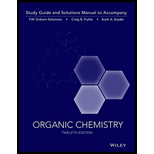
When ethyl bromide reacts with potassium cyanide in methanol, the major produce is
Want to see the full answer?
Check out a sample textbook solution
Chapter 6 Solutions
Organic Chemistry, 12e Study Guide/Student Solutions Manual
Additional Science Textbook Solutions
Living by Chemistry
Inorganic Chemistry
Principles of Chemistry: A Molecular Approach (3rd Edition)
Chemistry: An Introduction to General, Organic, and Biological Chemistry (13th Edition)
The Organic Chem Lab Survival Manual: A Student's Guide to Techniques
Introductory Chemistry (6th Edition)
- Reaction of iodoethane with CN- yields a small amount of isonitrile, CH3CH2N≡C, along with the nitrile CH3CH2N≡N, as the major product. Write electron-dot structures for both products, assign formal charges as necessary, and propose mechanisms to account for their formation.arrow_forwardAn unknown hydrocarbon Q has a formula C6H12. Q reacts with osmium tetroxide to give a diol R when oxidized with KMnQ4 in an acidic medium Q gives two products. One product is propanoic acid and the other is ketone S. Provide reaction equations to identify the possible structures of Q, R and S.arrow_forward(b) (1-chloromethyl)cyclopentane, C6H11CI reacts with aqueous sodium hydroxide, NaOH to produce a primary alcohol AA. When CsH11Cl is added with magnesium, Mg in ether, an organometallic compound BB is formed. When compound BB reacts with ethanal, CH3CHO, a secondary alcohol cC is formed. The molecular structure of C6H11CI is given below. (1-klorometil)siklopentana, C6H11CI bertindak balas dengan akues natrium hidroksida, NaOH bagi menghasilkan satu alkohol primer AA. Apabila C6H11CI ditambah dengan magnesium, Mg dalam eter, sebatian organologam BB terbentuk. Apabila sebatian BB bertindak balas dengan etanal, CH3CHO, satu alkohol sekunder CC dihasilkan. Struktur molekul bagi C6H11CI diberikan di bawah. (1-chloromethyl)cyclopentanearrow_forward
- Interpret the acidity of alcohols on the basis of ground-state polarization and stability of the alcoholate anion(indicate and give symbols for bond polarization)! Compare the relative acidity of ethanol and 2-fluoroethanol!arrow_forwardPropose a reasonable mechanism for the reaction, drawing out Lewis structure, using arrows to show electron flow, clearly identifying the bond making/bond breaking steps, and proposing reasonable intermediates for the reaction.arrow_forwardCalculate the enthalpy of formation of propane from:a. Combustion data (ΔHc = –2217 kJ mol–1; ΔHf (CO2) = –393.4 kJ mol–1, ΔHf (H2O) =–285.2 kJ mol–1);b. Bond enthalpies (C–C 348 kJ mol–1; C–H 413 kJ mol–1; H–H 436 kJ mol–1; ΔHvap forcarbon = –717 kJ mol–1).arrow_forward
- (a) (i) 3-Methyl-2-butanol will react with sulphuric acid to give two isomeric alkenes in 3:1 proportions.(i) Write down the structures for these alkenes and assign appropriate systematic names to them. (ii) Name the most abundant isomer. (iii) Write down detailed mechanism for the formation of a minor product.arrow_forwardThe compound below is treated with chlorine in the presence of light. CH2CH3 Draw the structure for the organic radical species produced by reaction of the compound with a chlorine atom. Assume reaction occurs at the weakest С-H bond.arrow_forwardThe pentadienyl radical, H2C“CH¬CH“CH¬CH2#, has its unpaired electron delocalized over three carbon atoms.(a) Use resonance forms to show which three carbon atoms bear the unpaired electron.(b) How many MOs are there in the molecular orbital picture of the pentadienyl radical?arrow_forward
- The sex attractant of the common housefly is a hydrocarbon with the formula C23H46. On treatment with aqueous acidic KMNO4, two products are obtained, CH3(CH2)12CO;H and CH3(CH2),CO2H. Propose a structure.arrow_forwardChemical Equilibrium Write the equilibrium-constant expressions and obtain numerical values for each constant in (a) the basic dissociation of aniline, C6H5NH2. (b) the acidic dissociation of hypochlorous acid, HClO. (c) the acidic dissociation of methyl ammonium hydrochloride, CH3NH3Cl. (d) the basic dissociation of NaNO2. (e) the dissociation of H3AsO3 to H3O+ and AsO33- Using step-by-step processarrow_forwardThe compound whose structure is shown here is acetyl acetone. It exists in two forms:the enol form and the keto form The molecule reacts with OH–to form an anion, [CH3COCHCOCH3] (often abbreviatedacac–for acetylacetonate ion). One or the most interesting aspects of this anion is thatone or more of them can react with transition metal cations to give stable, highlycolored compounds (a) Are the keto and enol forms of acetylacetone resonance forms? Explain youranswer.(b) What is the hybridization or each atom (except H) in the enol form? What changesin hybridization occur when it is transformed into the keto form?(c) What are the electron-pair geometry and molecular geometry around each C atomin the keto and enol forms? What changes in geometry occur when the keto formchanges to the enol form?(d) Draw three possible resonance structures for the acac–ion.(e) Is cis-trans isomerism possible in either the enol or the keto form of acetylacetone?(f) Is the enol form of acetylacetone polar?…arrow_forward
